Mr. Murphy came to visit, this week. You know Murphy? As in Murphy’s Law?
It started with Tropical Storm Sally, which the weatherguessers said would go to Louisiana. Poor Louisiana, they don’t need any more of this stuff. Upon update, it had shifted a bit east toward the Louisiana/Mississippi border and would be a Category One storm. They would get the wind damage and we would get much of the rain in Florida. I didn’t want rain. I have been waiting for the river to get low enough for an archaeology project and it was almost “there.” Then the storm was going to Mississippi as a Cat 2. I started to get a little concerned. I have a lot of construction projects going on around the farm and a proper prep would be impossible. I put some plywood and straps on piles of solar panels and picked up the loosest stuff, just in case the winds picked up.
Then they said it would shift to Alabama. To make a long story short, it made landfall on the Alabama/Florida border and headed straight to my house. This was a water storm. 30-36″ of rain, they say. I don’t know that anybody knows for sure, but if you had parked your car in downtown Pensacola, you got water in the glove box. Right on the coast you had the worst winds. A highrise apartment building had a wall ripped off. Barges got loose and busted a brand new bridge. Trees fell on houses and cars. In a nutshell, it sucked to be us. I’ve seen worse, though.
I thought it might be valuable to take a look at the aftermath to see how inverters, batteries, generators and solar panels in various emergency power configurations helped or held up. We’ll start with my brother, who lives in Pensacola. In a rare concession to weather, he drove his truck to work that night, instead of his motorcycle. With the flooding, getting from the hospital back home was iffy in the tallish Z71. The house is on a hillside, near the bay bluffs, so there was no flooding there, but water had made its way through the roof, somehow, coming out the a/c vents of his upstairs man cave. Oaks were on most of his neighbors’ cars, as well as one of his. Mr. Survival got into gear with his rechargeable electric chainsaw and freed up the neighborhood. He always does that, but this is the first time with the electric saw. Then he connected an inverter to the truck and ran a cord into the house to give lights, run the small appliances and keep the fridge cool. Previously he had maintained a tub of batteries on the balcony for backup power, but abandoned that idea. If you have a long stretch between storms, then the batteries may die before you need them. The batteries in the pickup are used frequently, so they are maintained. A separate battery and inverter ran his CPAP machine and a lamp upstairs. No solar, here. We’ve been talking about a solar awning for the kitchen window and I think that would be just dandy. The problem, here, is that it was a gonna-do project and not done.
His freezer has an alarm on it. He would run the truck until the freezer hit 0 degrees and shut down until the temperature rose to 22F. The truck would get a break of around 5 hours. He also made an interesting observation that you may keep in mind. The chest freezer releases heat through its outer skin. He put a small table fan to work, blowing on the freezer and it cut cool-down time dramatically, reducing the truck’s run time even more!
Jane is on the same power co-op as I am, which lost 96% of their connections. At Jane’s house, her 10kw solar power system had been disconnected and disabled. She’s selling the house and the solar system was not approved. The panel array is hinged and had two sets of rear struts for seasonal changes. When I shut down the system, I put in the summer struts, which laid the panels nearly flat. The anchors are steel pipe in concrete. That may have saved them from being blown away. The generator circuit was left in place.
The structures and most of the trees were good. The house lost some flashing and the pecan and corn crops were wiped out. Naturally, the power was out, but it went out later than anyone would have guessed. Neighbor Mark arrived and proceeded to try to restore power. By the time I arrived, he had the Winco pto generator attached to a New Holland Boomer tractor. A 250 gallon diesel tank was parked next to it. The Boomer really uses a lot of fuel. The wiring at the barn routed the generator through one of the inverters. It should have transferred through to the house, but we’ll never know. Mark decided to rewire things to a state he could understand, which was making the wire go directly from Point A to Point B. It wasn’t pretty, but it was there and understandable. Up at the house, he was scratching his head for an hour as to why the transfer switch was not providing power to the house. He had a power indicator probe that showed things to be hot, but the lights didn’t come on. My analysis determined that the light switch was not turned on. The lights in the kitchen were on, but not in the garage where the panel is. Where Mark was.
Mark seems like a pretty bright guy, but he got flustered going into a strange system. We all had a laugh and breathed a sigh of relief. There was just one thing…the a/c was not running. That one had us going for a while. I had visited after a previous hurricane and had seen the windows fogged up, the a/c was so cold in the house, powered by that generator. I knew the generator would power the whole system, but I overlooked the fact that this was BEFORE the solar power system was configured. We could not figure why there was no power to the air handler, which also has the 24v transformer that turns on the compressor, which did have power. Turns out, the meter is on a “power pack” base. This sort of base has some breakers in it for the heavy stuff. That is where we finally found the breaker for the air handler. An a/c blower is often only 1/3 hp or maybe 300 watts. However, in a heat pump system, you usually have emergency heat strips, which can burn up insane amounts of electricity. Hence, the 50 amp breaker. The compressor was originally done the same way, but provision had been made to accommodate it. I would suggest you avoid a power pack meter base if you intend to have solar or backup power. It just complicates things, in my opinion. We ended up making a temporary accommodation that would A: Not electrocute a power company employee B: Not blow up when the power was restored, and C: Make the a/c run. Jane was happy. The moral to that story is, if you have alternate power configurations, make sure you test everything in every configuration. We have no way of knowing if Tom was aware of this quirk in his system. He took that secret to his grave. After the grid was restored, I returned to Jane’s house to remove the “accommodation”.
At my late Mom’s house, there is a professionally installed LP generator. Everything is automatic and everything in the house works. We drove by in our after- storm tour and heard the Generac buzzing merrily. I’m sure the new owners were tickled pink.
I stopped to check on neighbor Connie. We had worked earlier to open the road in front of her house. Aside from the several trees down, she had lost part of the roof on one of her barns. This was the first time all of the roof stayed on her house! She was having problems getting her largish, rope-start generator to start. It had sat a while without use and was a little stiff. I gave a couple of mighty tugs and got it going. It loosened up. She uses marine (no alcohol) gas, but the old gas was still a little stinky. She topped it up (not running) and went off in search of more gas. She was lucky to find some up in Alabama, but a good practice is to buy the gas before the storm and use marine gas. When the power comes back on, let the generator run out of gas so the tank and carb don’t get gunked up. Change the oil before you put it away. You may need to use the generator, again, someday. She kept her food plenty cold.
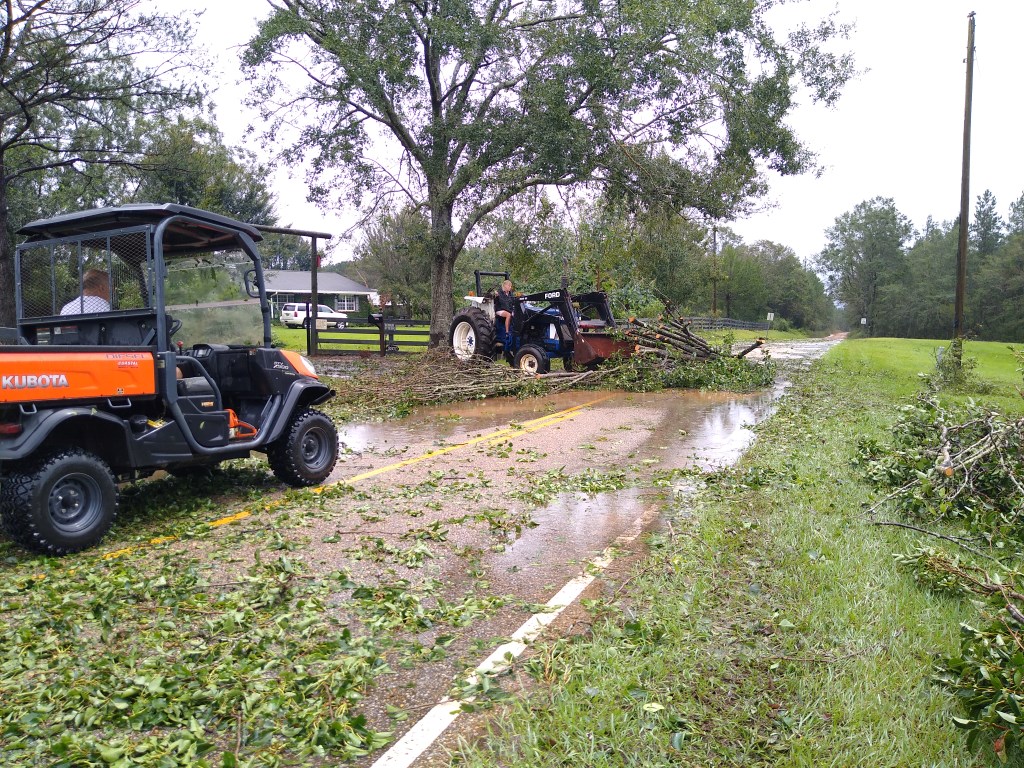
At my house, it could have been a lot worse. The driveway went from gully to gulch to crevasse, with a tunnel of fallen vegetation. The alternate path was blocked by an ancient oak, gone horizontal. That’s the one in the picture up top. The house needs a roof and I need to find the soffits, but it is reasonably dry inside. The solar power worked like a champ. Normally, you have clear skies after a hurricane. We had lots of cloudy days going into this one and coming out we have a tropical storm that is dumping rain on us. I recently did a battery upgrade and it paid off. The two tons of batteries did NOT blow away. Everything that was wired in worked. With 3 fridges, a freezer, a toaster, microwave, crockpot and coffeemaker we had no trouble preparing meals. What we did NOT have was the seldom-used electric range, the clothes dryer, and a/c. A/C could have been enabled with a simple jumper, but would have challenged the system because of lack of sunshine. It was cool enough without. Solar also powered our chainsaws and electric trucks for cleanup work.
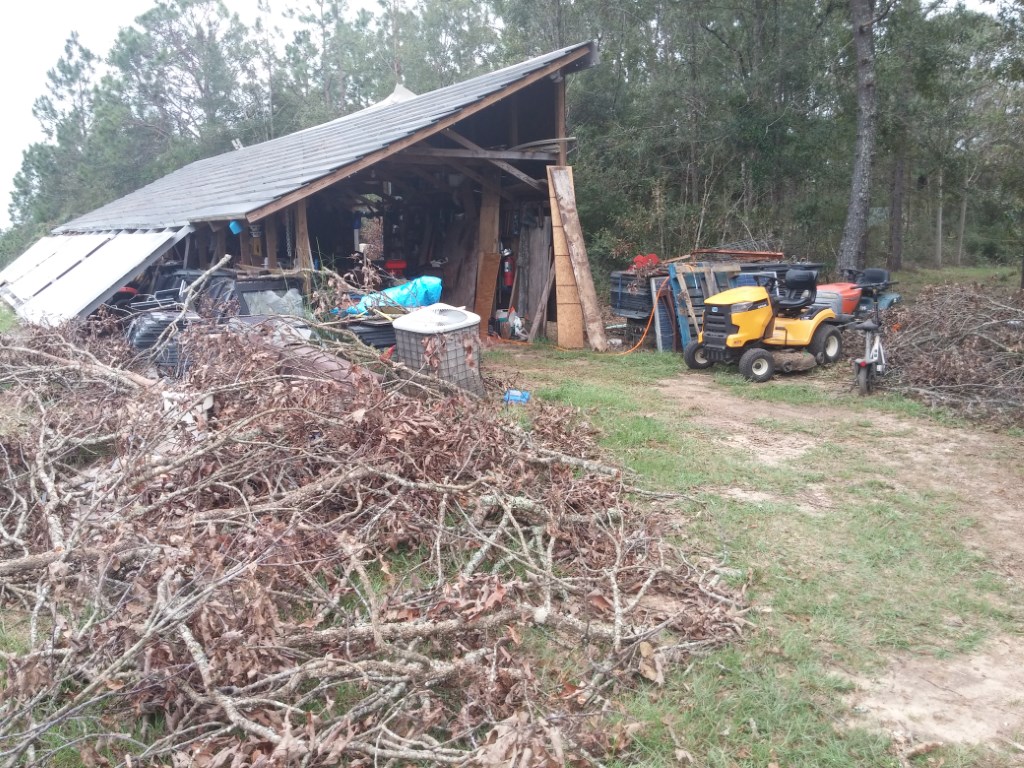
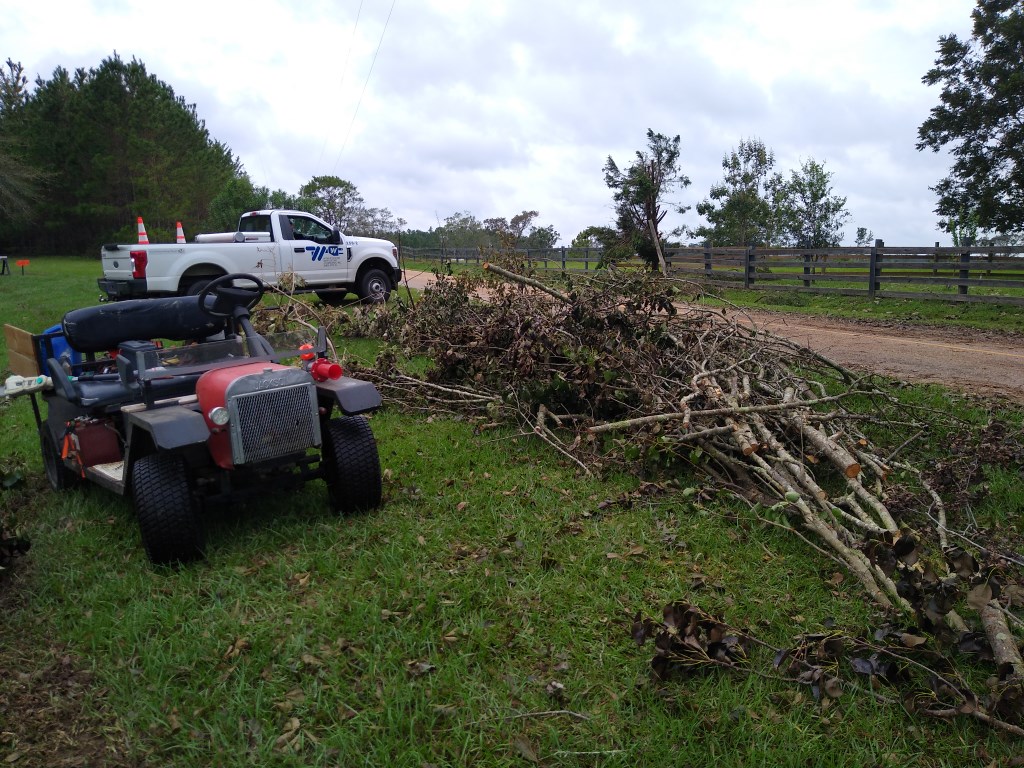
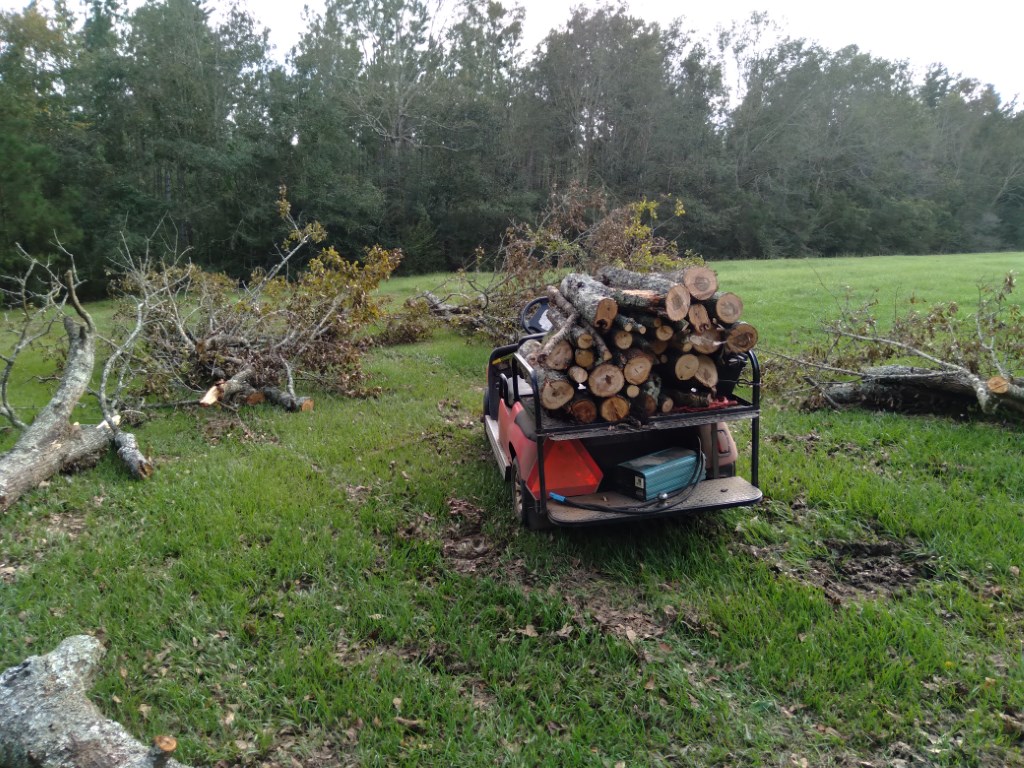
The structure of the Solar Shed was unproven and Sally came on us so quickly that I was unable to install internal X-bracing intended for storms. As we got the eye, we got wind from every direction. There was an inch of rain in a bucket INSIDE the shed. That can happen when the rain is going sideways, but the control room/ man cave stayed dry. When the wind was coming from the east, a LOT of heavy oak limbs went flying and scampered across the solar arrays. As far as I can tell, ONE of the solar shingles got smashed and it appears to still be working. I sweated the experimental arrays. I had previously written about staking them down, but some had been recently changed and were not staked. None went flying. I do need to restore the roof flashing.
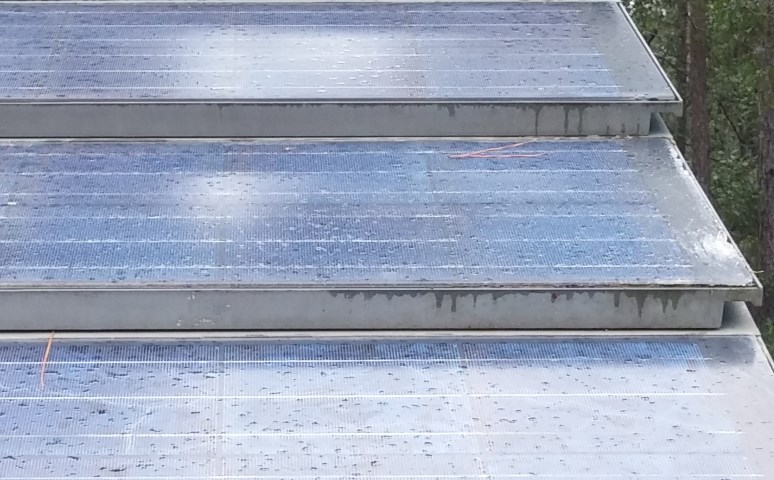
The power came back on remarkably quick, I think. We were without the grid for only 3 1/2 days. Really, the only thing we lacked was the clothes dryer and my wife acquiesced to using a clothesline for one load. We were going through a lot of laundry, doing cleanup. She did appreciate having lights, TV, Internet, hot showers, cold fridges, and hot food. She has decided it is OK that I spent all that money on the battery upgrade.–Neal
